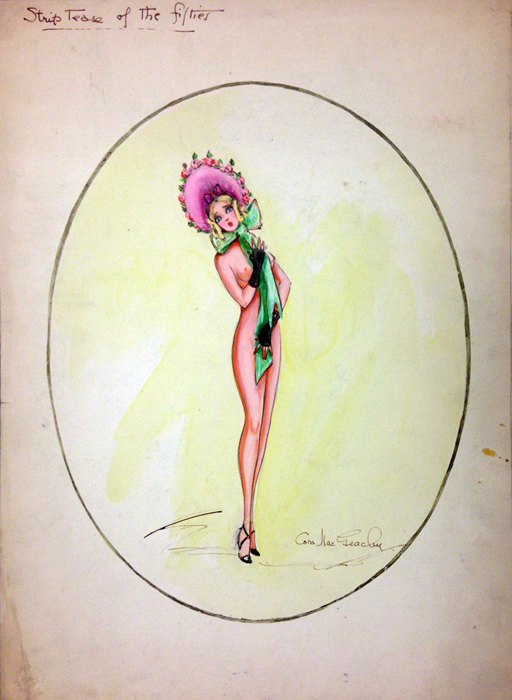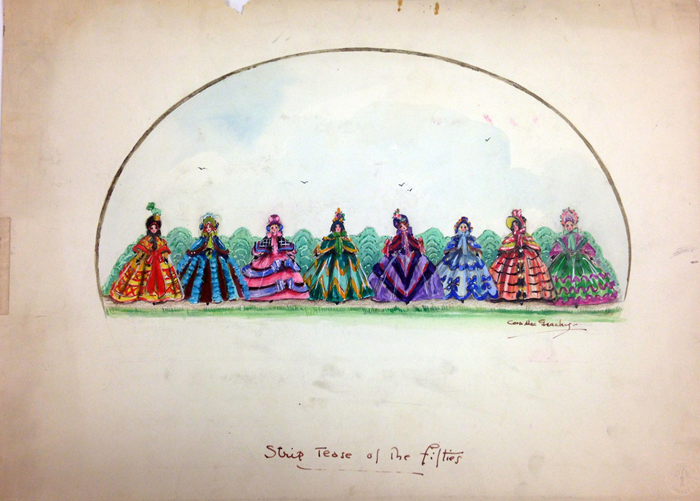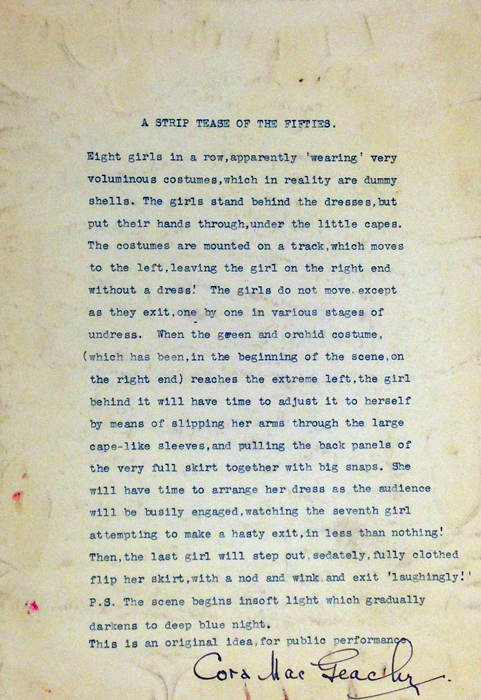Showgirls Costume Designer and Song Writer Cora MacGeachy
Tuesday, September 18, 2018 by
It is often challenging to find information on artists who work behind the scenes, especially if they were active 100 years ago. Cora MacGeachy, a costume designer and songwriter in the early 20th century, is an example of one such behind-the-scenes artist. Conducting research on her life and work was even more complicated because her last name was spelled several different ways – including McGeachy, Macgeachy, and Macgenchy – and she had two middle initials, L for Leith, and M, probably for her mother’s maiden name, Macey.
MacGeachy designed showgirls’ costumes for vaudeville and revues such as The Passing Show and Ziegfeld Follies on Broadway. Many upper class New Yorkers socialized at these shows, and her designs would have been seen by Follies’ notable regular audience members including Governor Alfred E. Smith, Mayor James Walker, and Bernard Baruch.
Some of the costumes for these shows were intended only to be worn on stage, but others had designs that were wearable off-stage. As a result, many women attended these performances with the same sense that people today go to fashion shows. Another designer from the same era, Mabel E. Johnston whom MacGeachy had collaborated with for The Merry Malones, primarily designed ball and pageant gowns for private clients in the 1930s, after having designed for revues in the 1920s. Unlike Johnston, however, MacGeachy does not appear to have applied her talents in the everyday fashion world.
Instead, MacGeachy’s creativity expanded onstage and stayed onstage. MacGeachy did not just design costumes, she visualized how the costumes should be presented. For example, on the back of renderings for Strip tease of the Fifties from Yes I don’t Know, she wrote out the steps how the dress from one of the eight girls on stage is removed in a matter of seconds for costume changes.
Her creativity onstage also expanded to composing music and writing lyrics. One of her earlier music gigs was for Julian Eltinge’s His Night at the Club in 1919, which included female impersonators and a Japanese butler played by an actor named Sina Nakada. She also composed and wrote lyrics for the Broadway hit song “Louisville Love” in Ned Wayburn’s Song Scenes in 1920, and words for the song “Hymn to the United Nations” in 1955.
Her creativity outside of costume design might have been influenced by her theatrical family. Her father, Charles MacGeachy, who was born in Jamaica, was a theatrical manager for the show The Professor in 1882. Cora MacGeachy’s mother, Cora Macey, was one of the actresses for this show. Macey had already been known as a singer and actress in her hometown of Chicago by the time she appeared in The Professor. Cora and Charles married in 1883, and MacGeachy was born in 1884. At the time, they lived on West 23rd Street in Manhattan.
MacGeachy’s parents were separated sometime before she turned 20. She lived with her mother and her step-father most of her young adulthood in Brooklyn. When her mother and her step-father moved to Maryland, she stayed in New York City and worked as a successful costume designer while living alone on West 70th Street.
A few years after she was reunited with her mother, they both moved to California. In Hollywood in 1926, MacGeachy designed costumes for the silent film “Irene,” in which her singer and actress mother made her screen debut. When Macey was not on screen, she also worked as a stage costumer well into her seventies. The mother and the daughter worked in costumes and music, sometimes collaborating, for the rest of their lives.
Thanks to a recent grant from the Institute of Museum and Library Services, the costume design renderings by Cora MacGeachy will be digitized, cataloged, and made publicly available via the Museum’s online Collections Portal, along with nearly 8,000 costume and set renderings in the Museum’s collection from over 400 productions.






